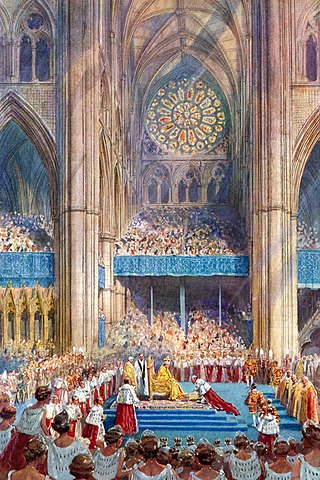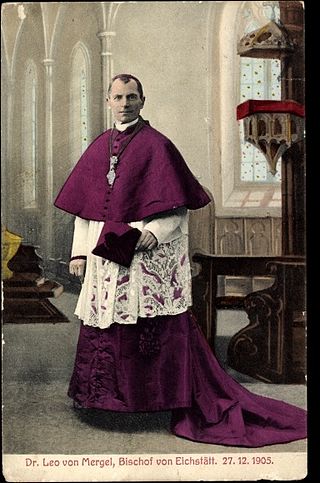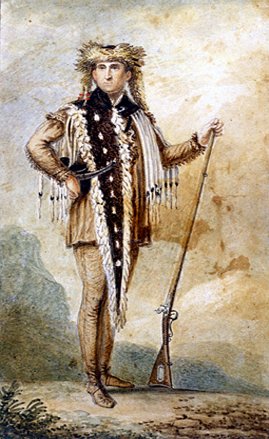An Honorary Chaplain to the King is a member of the clergy within the United Kingdom who, through long and distinguished service, is appointed to minister to the monarch of the United Kingdom. When the reigning monarch is female, Honorary Chaplains are known as Honorary Chaplains to the Queen. As of 2008 [update] there are 33 appointees. [1] They are also known as Honorary Chaplains to the Sovereign. [2]
Honorary Chaplains wear a scarlet cassock and a special bronze badge consisting of the royal cypher and crown within an oval wreath. The badge is worn below medal ribbons or miniature medals during the conduct of religious services on the left side of the scarf by chaplains who wear the scarf and on academic or ordinary clerical dress by other chaplains. [3]
Ten ministers of the Church of Scotland are appointed as Chaplains to the King in Scotland. [4]
The monarch may also, as circumstances dictate, appoint extra chaplains. [5]

The Most Excellent Order of the British Empire is a British order of chivalry, rewarding contributions to the arts and sciences, work with charitable and welfare organisations, and public service outside the civil service. It comprises five classes of awards across both civil and military divisions, the most senior two of which make the recipient either a knight if male or a dame if female. There is also the related British Empire Medal, whose recipients are affiliated with, but not members of, the order.

The cassock, also called soutane, is a Christian clerical clothing coat used by the clergy and male religious of the Oriental Orthodox Churches, Eastern Orthodox Church and the Catholic Church, in addition to some clergy in certain Protestant denominations such as Anglicans and Lutherans. "Ankle-length garment" is the literal meaning of the corresponding Latin term, vestis talaris. It is related to the habits traditionally worn by nuns, monks, and friars.

The Royal Victorian Order is a dynastic order of knighthood established in 1896 by Queen Victoria. It recognises distinguished personal service to the monarch, members of the royal family, or to any viceroy or senior representative of the monarch. The present monarch, King Charles III, is the sovereign of the order. The order's motto is Victoria. The order's official day is 20 June. The order's chapel is the Savoy Chapel in London.

The coronation of the monarch of the United Kingdom is an initiation ceremony in which they are formally invested with regalia and crowned at Westminster Abbey. It corresponds to the coronations that formerly took place in other European monarchies, which have all abandoned coronations in favour of inauguration or enthronement ceremonies. A coronation is a symbolic formality and does not signify the official beginning of the monarch's reign; de jure and de facto his or her reign commences from the moment of the preceding monarch's death or abdication, maintaining legal continuity of the monarchy.

The Supreme Governor of the Church of England is the titular head of the Church of England, a position which is vested in the British monarch. Although the monarch's authority over the Church of England is largely ceremonial and is mostly observed in a symbolic capacity, the position is still relevant to the established church. As the supreme governor, the monarch formally appoints high-ranking members of the church on the advice of the prime minister of the United Kingdom, who in turn acts on the advice of the Crown Nominations Commission. Since the Act of Settlement of 1701, all Supreme Governors have been members of the Church of England.

The Royal Army Chaplains' Department (RAChD) is an all-officer department that provides ordained clergy to minister to the British Army.

A chapel royal is an establishment in the British and Canadian royal households serving the spiritual needs of the sovereign and the royal family.
Canon is a Christian title usually used to refer to a member of certain bodies in subject to an ecclesiastical rule.
The Dean of the Chapel Royal, in any kingdom, can be the title of an official charged with oversight of that kingdom's chapel royal, the ecclesiastical establishment which is part of the royal household and ministers to it.
Clerical clothing is non-liturgical clothing worn exclusively by clergy. It is distinct from vestments in that it is not reserved specifically for use in the liturgy. Practices vary: clerical clothing is sometimes worn under vestments, and sometimes as the everyday clothing or street wear of a priest, minister, or other clergy member. Eastern Orthodox clerical clothing is a subset of a monk's habit.

Choir dress is the traditional vesture of the clerics, seminarians and religious of Christian churches worn for public prayer and the administration of the sacraments except when celebrating or concelebrating the Eucharist. It differs from the vestments worn by the celebrants of the Eucharist, being normally made of fabrics such as wool, cotton or silk, as opposed to the fine brocades used in vestments. It may also be worn by lay assistants such as acolytes and choirs. It was abandoned by most of the Protestant churches that developed from the sixteenth-century Reformation.
The Ecclesiastical Household is a part of the Royal Household of the sovereign of the United Kingdom. Reflecting the different constitutions of the churches of England and Scotland, there are separate households in each nation.

A tippet is a piece of clothing worn over the shoulders in the shape of a scarf or cape. Tippets evolved in the fourteenth century from long sleeves and typically had one end hanging down to the knees. A tippet could also be the long, narrow, streamer-like strips of fabric - attached with an armband just above the elbow - that hung gracefully to the knee or even to the ground. In later fashion, a tippet is often any scarf-like wrap, usually made of fur, such as the sixteenth-century zibellino or the fur-lined capelets worn in the mid-18th century.

Sir Iain Richard Torrance, is a retired Church of Scotland minister, theologian and academic. He is Pro-Chancellor of the University of Aberdeen, Honorary Professor of Early Christian Doctrine and Ethics at the University of Edinburgh, President and Professor of Patristics Emeritus at Princeton Theological Seminary, and an Extra Chaplain to Her Majesty Queen Elizabeth II in Scotland. He was formerly Moderator of the General Assembly of the Church of Scotland, Dean of the Chapel Royal in Scotland, and Dean of the Order of the Thistle. He is married to Morag Ann, whom he met while they were students at the University of St Andrews, and they have two children.
The Royal Australian Army Chaplains' Department (RAAChD) is an all-officer corps of the Australian Army that provides ordained clergy to minister to the personnel of the Australian Army. RAAChD chaplains belong to either one of several Christian churches, or to the Jewish faith. As of 2012, there are 67 serving regular chaplains (commonly known as 'padres') in the Australian Army. There are also 83 chaplains in the Australian Army Reserve.
Archibald Main, was a Scottish ecclesiastical historian, Church of Scotland minister, military chaplain, and academic. From 1915 to 1922, he was Professor of Ecclesiastical History at the University of St Andrews. From 1922 to 1942, he was Regius Professor of Ecclesiastical History at the University of Glasgow. He served as Chaplain to the King from 1925 and as Moderator of the General Assembly of the Church of Scotland from 1939 to 1940.
Mary Irene Levison was the first person to petition the Church of Scotland for the ordination of women to the Ministry of Word and Sacrament in 1963. This was achieved five years later and Levison became a minister in 1973. In 1991 she was appointed as Queen's Chaplain, the first woman to hold the position.
The Rev. Sir Francis Arthur Stanley ffolkes, 5th Baronet was an English baronet and Anglican priest who served successive monarchs of the United Kingdom as an Honorary Chaplain and Chaplain-in-Ordinary.

Air Vice-Marshal Giles Leslie Legood, is a British Anglican priest. Since July 2022 he has served as Chaplain-in-Chief of the Royal Air Force Chaplains Branch and Archdeacon for the Royal Air Force. He previously served as Deputy Chaplain-in-Chief.
Anna Eltringham is an Anglican bishop. Since 2023 she has served as Bishop of Ripon in the Diocese of Leeds. From 2014 to 2023, she served as Team leader of the Oxted benefice.